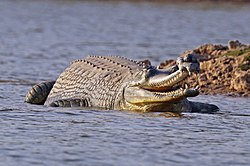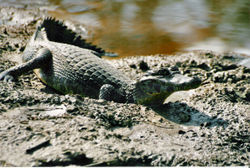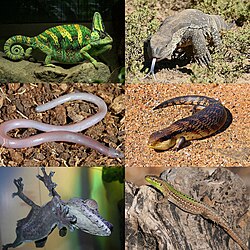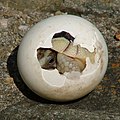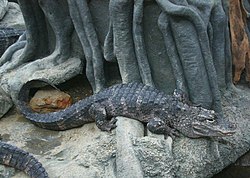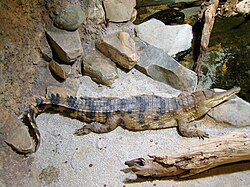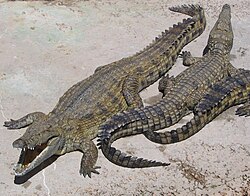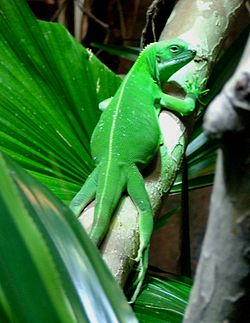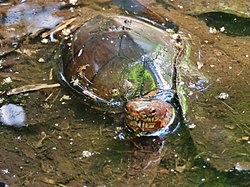Portal:Reptiles
Portal maintenance status: (June 2018)
|
The Reptiles Portal
Reptiles, as commonly defined, are a group of tetrapods with an ectothermic metabolism and amniotic development. Living traditional reptiles comprise four orders: Testudines, Crocodilia, Squamata, and Rhynchocephalia. About 12,000 living species of reptiles are listed in the Reptile Database. The study of the traditional reptile orders, customarily in combination with the study of modern amphibians, is called herpetology.
Reptiles have been subject to several conflicting taxonomic definitions. In evolutionary taxonomy, reptiles are gathered together under the class Reptilia (/rɛpˈtɪliə/ rep-TIL-ee-ə), which corresponds to common usage. Modern cladistic taxonomy regards that group as paraphyletic, since genetic and paleontological evidence has determined that crocodilians are more closely related to birds (class Aves), members of Dinosauria, than to other living reptiles, and thus birds are nested among reptiles from a phylogenetic perspective. Many cladistic systems therefore redefine Reptilia as a clade (monophyletic group) including birds, though the precise definition of this clade varies between authors. A similar concept is clade Sauropsida, which refers to all amniotes more closely related to modern reptiles than to mammals.
The earliest known members of the reptile lineage appeared during the late Carboniferous period, having evolved from advanced reptiliomorph tetrapods which became increasingly adapted to life on dry land. Genetic and fossil data argues that the two largest lineages of reptiles, Archosauromorpha (crocodilians, birds, and kin) and Lepidosauromorpha (lizards, and kin), diverged during the Permian period. In addition to the living reptiles, there are many diverse groups that are now extinct, in some cases due to mass extinction events. In particular, the Cretaceous–Paleogene extinction event wiped out the pterosaurs, plesiosaurs, and all non-avian dinosaurs alongside many species of crocodyliforms and squamates (e.g., mosasaurs). Modern non-bird reptiles inhabit all the continents except Antarctica. (Full article...)
Reptile types
-
Image 1
The tuatara (/tuːəˈtɑːrə/, Māori: [ˈtʉ.a.ta.ɾa]; Sphenodon punctatus) is a species of reptile endemic to New Zealand. Despite its close resemblance to lizards, it is the only extant member of a distinct lineage, the previously highly diverse order Rhynchocephalia. The name tuatara is derived from the Māori language and means "peaks on the back". (Full article...) -
Image 2Blanus cinereus, Spain
Amphisbaenia /æmfɪsˈbiːniə/ (called amphisbaenians or worm lizards) is a group of typically legless lizards, comprising over 200 extant species. Amphisbaenians are characterized by their long bodies, the reduction or loss of the limbs, and rudimentary eyes. As many species have a pink body and scales arranged in rings, they have a superficial resemblance to earthworms. While the genus Bipes retains forelimbs, all other genera are limbless. Phylogenetic studies suggest that they are nested within Lacertoidea, closely related to the lizard family Lacertidae. Amphisbaenians are widely distributed, occurring in North America, Europe, Africa, South America, Western Asia and the Caribbean. Most species are less than 6 inches (15 cm) long. (Full article...) -
Image 3Aldabra giant tortoise
(Aldabrachelys gigantea)
Tortoises (/ˈtɔːrtəs.ɪz/ TOR-təs-iz) are reptiles of the family Testudinidae of the order Testudines (Latin for "tortoise"). Like other testudines, tortoises have a shell to protect from predation and other threats. The shell in tortoises is generally hard, and like other members of the suborder Cryptodira, they retract their necks and heads directly backward into the shell to protect them. (Full article...) -
Image 4
Turtles are reptiles of the order Testudines, characterized by a special shell developed mainly from their ribs. Modern turtles are divided into two major groups, the Pleurodira (side necked turtles) and Cryptodira (hidden necked turtles), which differ in the way the head retracts. There are 360 living and recently extinct species of turtles, including land-dwelling tortoises and freshwater terrapins. They are found on most continents, some islands and, in the case of sea turtles, much of the ocean. Like other amniotes (reptiles, birds, and mammals) they breathe air and do not lay eggs underwater, although many species live in or around water. (Full article...) -
Image 5
Snakes are elongated limbless reptiles of the suborder Serpentes (/sɜːrˈpɛntiːz/). Cladistically squamates, snakes are ectothermic, amniote vertebrates covered in overlapping scales much like other members of the group. Many species of snakes have skulls with several more joints than their lizard ancestors and relatives, enabling them to swallow prey much larger than their heads (cranial kinesis). To accommodate their narrow bodies, snakes' paired organs (such as kidneys) appear one in front of the other instead of side by side, and most only have one functional lung. Some species retain a pelvic girdle with a pair of vestigial claws on either side of the cloaca. Lizards have independently evolved elongate bodies without limbs or with greatly reduced limbs at least twenty-five times via convergent evolution, leading to many lineages of legless lizards. These resemble snakes, but several common groups of legless lizards have eyelids and external ears, which snakes lack, although this rule is not universal (see Amphisbaenia, Dibamidae, and Pygopodidae). (Full article...) -
Image 6Nile crocodile (Crocodylus niloticus)
A crocodile (family Crocodylidae) or true crocodile is a large, semiaquatic reptile that lives throughout the tropics in Africa, Asia, the Americas and Australia. The term "crocodile" is sometimes used more loosely to include all extant members of the order Crocodilia, which includes the alligators and caimans (both members of the family Alligatoridae), the gharial and false gharial (both members of the family Gavialidae) as well as other extinct taxa. (Full article...) -
Image 7
The gharial (Gavialis gangeticus), also known as gavial or fish-eating crocodile, is a crocodilian in the family Gavialidae and among the longest of all living crocodilians. Mature females are 2.6 to 4.5 m (8 ft 6 in to 14 ft 9 in) long, and males 3 to 6 m (9 ft 10 in to 19 ft 8 in). Adult males have a distinct boss at the end of the snout, which resembles an earthenware pot known as a ghara, hence the name "gharial". The gharial is well adapted to catching fish because of its long, narrow snout and 110 sharp, interlocking teeth. (Full article...) -
Image 81905 photograph of an American alligator (top) and a Chinese alligator (bottom)
An alligator, or colloquially gator, is a large reptile in the genus Alligator of the family Alligatoridae in the order Crocodilia. The two extant species are the American alligator (A. mississippiensis) and the Chinese alligator (A. sinensis). Additionally, several extinct species of alligator are known from fossil remains. Alligators first appeared during the late Eocene epoch about 37 million years ago. (Full article...) -
Image 9Yacare caiman, Caiman yacare
A caiman (/ˈkeɪmən/ (also spelled cayman) from Taíno kaiman[additional citation(s) needed]) is an alligatorid belonging to the subfamily Caimaninae, one of two primary lineages within the Alligatoridae family, the other being alligators. Caimans are native to Central and South America and inhabit marshes, swamps, lakes, and mangrove rivers. They have scaly skin and live a fairly nocturnal existence. They are relatively small-sized crocodilians with an average maximum weight of 6 to 40 kg (13 to 88 lb) depending on species, with the exception of the black caiman (Melanosuchus niger), which can grow more than 4 m (13 ft) long and weigh more than 450 kg (990 lb). The black caiman is the largest caiman species in the world and is found in the slow-moving rivers and lakes that surround the Amazon basin. The smallest species is the Cuvier's dwarf caiman (Paleosuchus palpebrosus), which grows to 1.2 to 1.5 m (3.9 to 4.9 ft) long. There are six different species of caiman found throughout the watery jungle habitats of Central and Southern America. The average length for most of the other caiman species is about 2 to 2.5 m (6.6 to 8.2 ft) long. (Full article...) -
Image 10Clockwise from top left: veiled chameleon (Chamaeleo calyptratus), rock monitor (Varanus albigularis), common blue-tongued skink (Tiliqua scincoides), Italian wall lizard (Podarcis sicula), giant leaf-tailed gecko (Uroplatus fimbriatus), and legless lizard (Anelytropsis papillosus)
Lizard is the common name used for all squamate reptiles other than snakes (and to a lesser extent amphisbaenians), encompassing over 7,000 species, ranging across all continents except Antarctica, as well as most oceanic island chains. The grouping is paraphyletic as some lizards are more closely related to snakes than they are to other lizards. Lizards range in size from chameleons and geckos a few centimeters long to the 3-meter-long Komodo dragon. (Full article...)
Selected images
-
Image 1Photo: User:Benny TrappThe ladder snake (Rhinechis scalaris) is found mostly in peninsular Spain, Portugal, and southern France. It usually eats eggs, insects, and small mammals such as mice. The snake is now threatened by habitat loss.
-
Image 2Photo credit: Marcel Burkhard (cele4)The Plumed Basilisk (Basiliscus plumifrons) is a species of lizard native to Latin America. Its natural range covers a swath from Mexico to Ecuador.
-
Image 4Photograph credit: Basile MorinEutropis macularia, the bronze grass skink, is a species of lizard in the skink family, Scincidae, native to South and Southeast Asia. It lives in both deciduous and evergreen forests, in plantations, in grasslands, and in rocky areas with scattered trees. The species is active in both the day and the night, feeding on insects and other invertebrates. This bronze grass skink was photographed on a tree trunk on the island of Don Det in Laos.
-
Image 5Asian vine snake Ahaetulla prasina. This snake has a wide distribution in Asia. It feeds on small reptiles and amphibians, particularly lizards and tree frogs. Adults may attain 1.8 m (6 feet) in total length, with a tail 0.6 m (2 feet) long. Its appearance is very much like those of South American vine snakes. It is a rear-fanged species and is mildly venomous but is not considered a threat to humans.
-
Image 6A rare albino American Alligator (Alligator mississippiensis), a resident of the California Academy of Sciences in San Francisco, California. Typically olive, brown, gray or nearly black in color, the species is native only to wetlands of the Southern United States. American Alligators are nearly twice as large as the other extant alligator species, the Chinese Alligator.
-
Image 7Photo: Mbz1The green sea turtle (Chelonia mydas) is an endangered sea turtle found in tropical and subtropical seas around the world, with two distinct populations in the Atlantic and Pacific Oceans. The common name derives from the usually green fat found beneath its carapace.
-
Image 8Photograph: H. KrispPhelsuma grandis is a species of day gecko that lives in Madagascar. Found in a wide range of habitats, it can measure up to 30 centimetres (12 in) in length.
-
Image 9Photograph: Benny TrappVipera dinniki is a species of venomous viper which can reach 48.6 cm (19.1 in) in length. First described by Alexander Nikolsky in 1913, V. dinniki is found in the highlands of Russia, Georgia, and Azerbaijan.
-
Image 10Photograph: Steve JurvetsonThe western terrestrial garter snake (Thamnophis elegans) is a species of colubrid snake found in southwestern Canada and the western United States. It is the only species of garter snake with a well-documented tendency to constrict prey.
-
Image 11Photo credit: Rich TorresChamaeleo jacksonii, commonly known as Jackson's Chameleon or the Three-horned Chameleon, is an African chameleon. Native to the humid, cooler regions of Kenya and Tanzania, this specimen is from a feral population established in Hawaii in the 1970s. Males possess three brown horns, but females usually have none or just traces of the rostral horn (on the nose).
-
Image 13Cerastes cerastes, commonly known as the Saharan horned viper or the horned desert viper, is a venomous species of viper native to the deserts of northern Africa and parts of the Arabian Peninsula and Levant. It often is easily recognized by the presence of a pair of supraocular "horns", although hornless individuals do occur.
-
Image 14The American five-lined skink (Eumeces fasciatus) is one of the most common lizards in the eastern United States, as well as one of the five lizard species extant in Canada. It is a small to medium sized skink growing to about 12.5 to 21.5 cm (4.9 to 8.5 in). Juveniles (as seen here) are dark brown to black with five distinctive white to yellowish stripes running along the body and a bright blue tail.
-
Image 15Photograph: Didier DescouensA fossil of Steneosaurus bollensis, from the extinct genus of teleosaurid crocodyliforms Steneosaurus. This specimen was found in Holzmaden, Germany, and dates from the Early Jurassic (185 million years ago).
-
Image 16Cape skink – Trachylepis capensis. Close-up on purple Aster flowers.
-
Image 17The African striped skink (Trachylepis striata) is a skink native to southern Africa. Individuals are brown or bronze-coloured with two yellowish stripes that run lengthwise on either side of the spine. Both sexes grow to a length of about 25 centimetres (10 in).
-
Image 18Photo credit: LiquidGhoulThe head of a Coastal Carpet Python, the largest subspecies of Morelia spilota, a non-venomous Australian python, showing its forked tongue, a feature common to many reptiles, who smell using the tip of their tongue. Having a forked tongue allows them to tell which direction a smell is coming from.
-
Image 20Photo credit: Paul HirstAn anole lizard of the family Polychrotidae found in Hilo, Hawaii, United States. Anoles are small and common lizards that can be found throughout the various regions of the Western Hemisphere. They are frequently and incorrectly called chameleons or geckos due to their ability to alter their skin color and run up walls, respectively.
-
Image 21A baby marginated tortoise hatchling emerges from its shell.
-
Image 22Photograph credit: Holger KrispCerastes cerastes, commonly known as the Saharan horned viper or the horned desert viper, is a venomous viper species native to the deserts of northern Africa and parts of the Middle East. It commonly has a pair of supraocular "horns", although hornless individuals do occur. The colour pattern consists of a yellowish, pale grey, pinkish, reddish or pale brown ground colour, which almost always matches the substrate colour where the animal is found. Dorsally, a series of dark, semi-rectangular blotches runs the length of the body. The belly is white and the tail, which may have a black tip, is usually thin.
-
Image 24Photo credit: John O'NeillA common snakeneck turtle (Chelodina longicollis) covered in camouflaging algae. When resting this individual would look like an algae-covered rock, an example of crypsis, the ability of an organism to avoid observation. Other ways an organism may be cryptic include nocturnality, subterranean lifestyle, and transparency.
-
Image 25Photograph credit: Charles J. SharpBosc's fringe-toed lizard (Acanthodactylus boskianus) is a medium-sized species of lizard found in northern Africa and the Arabian Peninsula. Active during the day, they are energetic foragers for insects and other small invertebrates, and are one of the most common lizards in their range. Males and females are similar in appearance, both having a snout-to-vent length of between 5 and 8 cm (2.0 and 3.1 in), but males are usually larger. The feet have long slender digits that are fringed. The dorsal surface is olive-grey with five longitudinal dark stripes, the middle one of which subdivides at the neck, while the ventral surface is whitish, but in the female, the underside of the tail becomes suffused with red during the breeding season. In juveniles, the tail is blue.
This picture shows two A. b. asper lizards photographed in Dana Biosphere Reserve, Jordan, engaging in a love bite, a courtship ritual that may be connected to certain chemical cues present in the skin.
Selected Crocodilia articles
-
Image 1A smooth-fronted caiman at Zoologischer Garten Berlin in Berlin, Germany
The smooth-fronted caiman (Paleosuchus trigonatus), also known as Schneider's dwarf caiman or Schneider's smooth-fronted caiman, is a crocodilian from South America, where it is native to the Amazon and Orinoco Basins. It is the second-smallest species of the family Alligatoridae, the smallest being Cuvier's dwarf caiman, also from tropical South America and in the same genus. An adult typically grows to around 1.2 to 1.6 m (3.9 to 5.2 ft) in length and weighs between 9 and 20 kg (20 and 44 lb). Exceptionally large males can reach as much as 2.3 m (7.5 ft) in length and 36 kg (79 lb) in weight. (Full article...) -
Image 2West African crocodile in Bazoulé, Burkina Faso
The West African crocodile, desert crocodile, or sacred crocodile (Crocodylus suchus) is a species of crocodile related to, and often confused with, the larger Nile crocodile (C. niloticus). (Full article...) -
Image 3
The freshwater crocodile (Crocodylus johnstoni), also known commonly as the Australian freshwater crocodile, Johnstone's crocodile, and the freshie, is a species of crocodile native to the northern regions of Australia. Unlike its much larger Australian relative, the saltwater crocodile, the freshwater crocodile is not known as a man-eater, although it bites in self-defence, and brief, nonfatal attacks have occurred, apparently the result of mistaken identity. (Full article...) -
Image 4

The black caiman (Melanosuchus niger) is a crocodilian reptile endemic to South America. With a maximum length of around 5 to 6.5 m (16 to 21 ft) and a mass of over 450 kg (1,000 lb), it is the largest living species of the family Alligatoridae, and the third-largest crocodilian in the Neotropical realm. True to its common and scientific names, the black caiman has a dark greenish-black coloration as an adult. In some individuals, the pigmentation can appear almost jet-black. It has grey to brown banding on the lower jaw; juveniles have a more vibrant coloration compared to adults, with prominent white-pale yellow banding on the flanks that remains present well into adulthood (more than most other species). The banding on young helps with camouflage by breaking up their body outline, on land or in water, in an effort to avoid predation. The morphology is quite different from other caimans but the bony ridge that occurs in other caimans is present. The head is large and heavy, an advantage in catching larger prey. Like all crocodilians, caimans are long, squat creatures, with big jaws, long tails and short legs. They have thick, scaled skin, and their eyes and noses are located on the tops of their heads. This enables them to see and breathe while the rest of their bodies are underwater.
A carnivorous animal, the black caiman lives along freshwater habitats, including slow-moving rivers, lakes and seasonally flooded savannas, where it preys upon a variety of fish, reptiles, birds, and mammals. Being an apex predator and potentially a keystone species, it is generalist, capable of taking most animals within its range, and might have played a critical role in maintaining the structure of the ecosystem. Although only a mere few specific ecological studies have been conducted, it is observed that this species has its own niche which allows coexistence with other competitors. (Full article...) -
Image 5Mato Grosso, Brazil
The yacare caiman (Caiman yacare), also known commonly as the jacare caiman, Paraguayan caiman, piranha caiman, red caiman, and southern spectacled caiman, is a species of caiman, a crocodilian in the family Alligatoridae. The species is indigenous to Argentina, Bolivia, Brazil, and Paraguay. Brown in color and covered with dark blotches, males grow to a total length (including tail) of 2–3 m (6 ft 7 in – 9 ft 10 in) and weigh around 40–50 kg (88–110 lb); while females grow to 1.4 m (4 ft 7 in) long and about 15–20 kg (33–44 lb). Typical habitats of this caiman include lakes, rivers, and wetlands. Its diet primarily consists of aquatic animals, such as snails, and occasionally land vertebrates. Mating occurs in the rainy season and eggs hatch in March, with young fending for themselves as soon as they hatch. The yacare caiman was hunted heavily for its skin to use for leather in the 1980s, which caused its population to decrease significantly. However, trading restrictions placed since have caused its population to increase. Its population in the Pantanal is about 10 million, and it is listed as least concern on the IUCN Red List. (Full article...) -
Image 6
The gharial (Gavialis gangeticus), also known as gavial or fish-eating crocodile, is a crocodilian in the family Gavialidae and among the longest of all living crocodilians. Mature females are 2.6 to 4.5 m (8 ft 6 in to 14 ft 9 in) long, and males 3 to 6 m (9 ft 10 in to 19 ft 8 in). Adult males have a distinct boss at the end of the snout, which resembles an earthenware pot known as a ghara, hence the name "gharial". The gharial is well adapted to catching fish because of its long, narrow snout and 110 sharp, interlocking teeth.
The gharial probably evolved in the northern Indian subcontinent. Fossil gharial remains were excavated in Pliocene deposits in the Sivalik Hills and the Narmada River valley. It currently inhabits rivers in the plains of the northern part of the Indian subcontinent. It is the most thoroughly aquatic crocodilian, and leaves the water only for basking and building nests on moist sandbanks. Adults mate at the end of the cold season. Females congregate in spring to dig nests, in which they lay 20–95 eggs. They guard the nests and the young, which hatch before the onset of the monsoon. The hatchlings stay and forage in shallow water during their first year, but move to sites with deeper water as they grow. (Full article...) -
Image 7At the Columbus Zoo and Aquarium in Powell, Ohio
The American alligator (Alligator mississippiensis), sometimes referred to as a common alligator or simply gator, is a large crocodilian reptile native to the Southeastern United States. It is one of the two extant species in the genus Alligator, and is larger than the only other living alligator species, the Chinese alligator.
Adult male American alligators measure 3.4 to 4.5 m (11.2 to 14.8 ft) in length, and can weigh up to 500 kg (1,100 lb), with unverified sizes of up to 5.84 m (19.2 ft) and weights of 1,000 kg (2,200 lb) making it the second longest and the heaviest of the family Alligatoridae, after the black caiman. Females are smaller, measuring 2.6 to 3 m (8.5 to 9.8 ft) in length. The American alligator inhabits subtropical and tropical freshwater wetlands, such as marshes and cypress swamps, from southern Texas to North Carolina. It is distinguished from the sympatric American crocodile by its broader snout, with overlapping jaws and darker coloration, and is less tolerant of saltwater but more tolerant of cooler climates than the American crocodile, which is found only in tropical and warm subtropical climates. (Full article...) -
Image 8

Cuvier's dwarf caiman (Paleosuchus palpebrosus) is a small crocodilian in the alligator family from northern and central South America. It is found in Bolivia, Brazil, Colombia, Ecuador, French Guiana, Guyana, Paraguay, Peru, Suriname, Trinidad and Venezuela. It lives in riverine forests, flooded forests near lakes, and near fast-flowing rivers and streams. It can traverse dry land to reach temporary pools and tolerates colder water than other species of caimans. Other common names for this species include the musky caiman, the dwarf caiman, Cuvier's caiman, and the smooth-fronted caiman (the latter name is also used for P. trigonatus). It is sometimes kept in captivity as a pet and may be referred to as the wedge-head caiman by the pet trade community.
Cuvier's dwarf caiman was first described by the French zoologist Georges Cuvier in 1807 and is one of only two species in the genus Paleosuchus, the other species being P. trigonatus. Their closest relatives are the other caimans in the subfamily Caimaninae. With a total length averaging 1.4 m (4.6 ft) for males and up to 1.2 m (3.9 ft) for females, Cuvier's dwarf caiman is not only the smallest extant species in the alligator and caiman family, but also the smallest of all crocodilians (unless the Congo dwarf crocodile is considered a valid species). An adult weighs around 5 to 7 kg (11 to 15 lb). Its lack of size is partly made up for by its strong body armor, provided by the bony bases to its dermal scales, which provides protection against predators. Juvenile dwarf caimans mainly feed on invertebrates, but also small fish and frogs, while adults eat larger fish, amphibians, and invertebrates, such as large molluscs. This caiman sometimes uses a burrow as shelter during the day and in the Pantanal may aestivate in the burrow to stay cool in the dry season. The female buries her eggs on a mounded nest and these take about 3 months to hatch. She helps the hatchlings to escape from the nest and provides some parental care for the first few weeks of their lives. This caiman has a wide range and large total population and the IUCN lists its conservation status as being of least concern. (Full article...) -
Image 9
The saltwater crocodile (Crocodylus porosus) is a crocodilian native to saltwater habitats, brackish wetlands and freshwater rivers from India's east coast across Southeast Asia and the Sundaland to northern Australia and Micronesia. It has been listed as Least Concern on the IUCN Red List since 1996. It was hunted for its skin throughout its range up to the 1970s, and is threatened by illegal killing and habitat loss. It is regarded as dangerous to humans.
The saltwater crocodile is the largest living reptile. Males can grow up to a weight of 1,000–1,500 kg (2,200–3,300 lb) and a length of 6 m (20 ft), rarely exceeding 6.3 m (21 ft). Females are much smaller and rarely surpass 3 m (9.8 ft). It is also called the estuarine crocodile, Indo-Pacific crocodile, marine crocodile, sea crocodile, and, informally, the saltie. A large and opportunistic hypercarnivorous apex predator, they ambush most of their prey and then drown or swallow it whole. They will prey on almost any animal that enters their territory, including other predators such as sharks, varieties of freshwater and saltwater fish including pelagic species, invertebrates such as crustaceans, various amphibians, other reptiles, birds, and mammals. (Full article...) -
Image 10
The Siamese crocodile (Crocodylus siamensis) is a medium-sized freshwater crocodile native to Indonesia (East Kalimantan and possibly other areas historically), Laos, Cambodia, Thailand and Vietnam. Historical records from Myanmar remain unverified. The species is critically endangered and already extirpated from many regions. Its other common names include Siamese freshwater crocodile, Singapore small-grain, and soft-belly. (Full article...) -
Image 11An adult basking on the island of Palawan, Philippines
The Philippine crocodile (Crocodylus mindorensis), also known as the Mindoro crocodile, the Philippine freshwater crocodile, the bukarot in Ilocano, and more generally as a buwaya in most Filipino lowland cultures, is one of two species of crocodiles found in the Philippines; the other is the larger saltwater crocodile (Crocodylus porosus). The Philippine crocodile, the species endemic only to the country, went from data deficient to critically endangered in 2008 from exploitation and unsustainable fishing methods, such as dynamite fishing. Conservation methods are being taken by the Dutch/Filipino Mabuwaya foundation, the Crocodile Conservation Society and the Zoological Institute of HerpaWorld in Mindoro island. It is strictly prohibited to kill a crocodile in the country, and it is punishable by law. (Full article...) -
Image 12At the Cincinnati Zoo
The Chinese alligator (Alligator sinensis; simplified Chinese: 鼍; traditional Chinese: 鼉; pinyin: tuó), also known as the Yangtze alligator (simplified Chinese: 扬子鳄; traditional Chinese: 揚子鱷; pinyin: yángzǐ'è), China alligator, or historically the muddy dragon, is a crocodilian endemic to China. It and the American alligator (A. mississippiensis) are the only living species in the genus Alligator of the family Alligatoridae. Dark gray or black in color with a fully armored body, the Chinese alligator grows to 1.5–2.1 metres (5–7 ft) in length and weighs 36–45 kilograms (80–100 lb) as an adult. It brumates in burrows in winter and is nocturnal in summer. Mating occurs in early summer, with females most commonly producing 20–30 eggs, which are smaller than those of any other crocodilian. The species is an opportunistic feeder, primarily eating fish and invertebrates. A vocal species, adults bellow during the mating season and young vocalize to communicate with their parents and other juveniles. Captive specimens have reached age 70, and wild specimens can live past 50.
Living in bodies of fresh water, the Chinese alligator's range is restricted to six regions in the province of Anhui, as well as possibly the provinces of Jiangsu and Zhejiang. Originally living as far away from its current range as Japan, the species previously had a wide range and population, but beginning in 6000 BC, multiple threats, such as habitat destruction, caused the species' population and range to decline. The population in the wild was about 1,000 in the 1970s, decreased to below 130 in 2001, and grew after 2003, with its population being about 300 as of 2017. Listed as critically endangered by the International Union for Conservation of Nature, multiple conservation actions have been taking place for this species. (Full article...) -
Image 13
The spectacled caiman (Caiman crocodilus), also known as the white caiman, common caiman, and speckled caiman, is a crocodilian in the family Alligatoridae. It is brownish-, greenish-, or yellowish-gray colored and has a spectacle-like ridge between its eyes, which is where its common name come from. It grows to a length of 1.4–2.5 m (4 ft 7 in – 8 ft 2 in) and a weight of 7–40 kg (15–88 lb), with males being both longer and heavier than females. Its diet varies seasonally, commonly consisting of crabs, fish, small mammals, amphibians and snails. Breeding occurs from May to August and 14–40 eggs are laid in July and August. This crocodilian has a large range and population; it is native to much of Latin America, and has been introduced to the United States, Cuba, and Puerto Rico. (Full article...) -
Image 14

The mugger crocodile (Crocodylus palustris) is a medium-sized broad-snouted crocodile, also known as mugger and marsh crocodile. It is native to freshwater habitats from south-eastern Iran to the Indian subcontinent, where it inhabits marshes, lakes, rivers and artificial ponds. It rarely reaches a body length of 5 m (16 ft 5 in) and is a powerful swimmer, but also walks on land in search of suitable waterbodies during the hot season. Both young and adult mugger crocodiles dig burrows to which they retreat when the ambient temperature drops below 5 °C (41 °F) or exceeds 38 °C (100 °F). Females dig holes in the sand as nesting sites and lay up to 46 eggs during the dry season. The sex of hatchlings depends on temperature during incubation. Both parents protect the young for up to one year. They feed on insects, and adults prey on fish, reptiles, birds and mammals.
The mugger crocodile evolved at least 4.19 million years ago and has been a symbol for the fructifying and destructive powers of the rivers since the Vedic period. It was first scientifically described in 1831 and is protected by law in Iran, India and Sri Lanka. Since 1982, it has been listed as Vulnerable on the IUCN Red List. Outside protected areas, it is threatened by conversion of natural habitats, gets entangled in fishing nets and is killed in human–wildlife conflict situations and in traffic accidents. (Full article...) -
Image 15
Mecistops is a genus of crocodiles, the slender-snouted crocodiles, native to sub-Saharan Africa. (Full article...) -
Image 16
The Orinoco crocodile (Crocodylus intermedius) is a critically endangered crocodile. Its population is very small, and they can only be found in the Orinoco river basin in Venezuela and Colombia. Extensively hunted for their skins in the 19th and 20th centuries, it is one of the most endangered species of crocodiles. It is a very large species of crocodilian; males have been reported up to 6.8 m (22 ft 4 in) in the past, weighing over 900 kg (2,000 lb), but such sizes do not exist today, 5.2 m (17 ft 1 in) being a more widely accepted maximum size. A large male today may attain 4.2 m (13 ft 9 in) in length and can weigh up to 450 kg (1,000 lb), while females are substantially smaller with the largest likely to weigh around 225 kg (496 lb). Sexual dimorphism is not as profound as in other crocodilian species. The coloration is light even in adults.
The ecology of the Orinoco crocodile is poorly documented in the wild, mostly due to its small population. It is thought to have a more piscivorous diet with an opportunistic nature, resulting in generalist predatory behaviour. It is an apex predator and preys on a variety of birds, mammals and reptiles, including caimans on occasion. Its prey base is mostly large predatory fish, challenging the general view by locals complaining about crocodiles hunting local fish to very low numbers. Reproduction takes place in the dry season when the water level is low. It is a hole nester and digs holes in the sand for its clutch of eggs. The females guard the nests and young for several years. (Full article...) -
Image 17
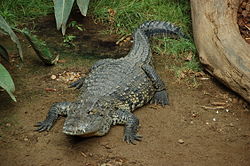
Morelet's crocodile (Crocodylus moreletii), also known as the Mexican crocodile or Belize crocodile, is a modest-sized crocodilian found only in the Atlantic regions of Mexico, Belize and Guatemala. It usually grows to about 3 metres (10 ft) in length. It is a species at least concern for extinction according to the International Union for Conservation of Nature.
The species has a fossil record in Guatemala. (Full article...) -
Image 18At Zapata Swamp, Matanzas Province, Cuba
The Cuban crocodile (Crocodylus rhombifer) is a small-medium species of crocodile endemic to Cuba. Typical length is 2.1–2.3 m (6 ft 11 in – 7 ft 7 in) and typical weight 70–80 kg (150–180 lb). Large males can reach as much as 3.5 m (11 ft) in length and weigh more than 215 kg (474 lb).
The Cuban crocodile is of interest to biologists for its unique physical and behavioral traits. Long- and strong-legged, it is the most terrestrial of extant crocodiles. Its preferred habitat comprises freshwater and brackish water environments, such as mangrove swamps, coastal lagoons, estuaries, marshes, floodplains, and river deltas. There, the adults feed on fish, turtles and small mammals, while the young eat invertebrates and smaller fish. Mating occurs between May and July. Captive animals have displayed cooperative hunting behavior, and can be taught tricks, suggesting intelligence. (Full article...) -
Image 19At São Paulo Zoo, Brazil
The broad-snouted caiman (Caiman latirostris) is a crocodilian in the family Alligatoridae found in eastern and central South America, including the Pantanal habitat of Bolivia, Southeast Brazil, and Paraguay, as well as northern Argentina and Uruguay. Behind the black caiman (Melanosuchus niger), it is the second-largest caiman species; it is the third-largest alligatorid behind the American alligator (Alligator mississippiensis) and the aforementioned black caiman. Primarily, the species inhabits freshwater wetlands, including floodplains, marshes, swamps, and some mangrove forests, as well as various streams, rivers, lakes or ponds, preferring bodies of rather still or slower-moving water. They will often utilize man-made cow ponds, disused stock tanks, and canals and ditches, as well. (Full article...) -
Image 20At Le Bonheur Crocodile Farm near Stellenbosch, South Africa
The Nile crocodile (Crocodylus niloticus) is a large crocodilian native to freshwater habitats in Africa, where it is present in 26 countries. It is widely distributed in sub-Saharan Africa, occurring mostly in the eastern, southern, and central regions of the continent, and lives in different types of aquatic environments such as lakes, rivers, swamps and marshlands. It occasionally inhabits deltas, brackish lakes and rarely also saltwater. Its range once stretched from the Nile Delta throughout the Nile River. Lake Turkana in Kenya has one of the largest undisturbed Nile crocodile populations.
Generally, the adult male Nile crocodile is between 3.5 and 5 m (11 ft 6 in and 16 ft 5 in) in length and weighs 225 to 750 kg (496 to 1,653 lb). However, specimens exceeding 6.1 m (20 ft) in length and 1,000 kg (2,200 lb) in weight have been recorded. It is the largest predator in Africa, and may be considered the second-largest extant reptile in the world, after the saltwater crocodile (Crocodylus porosus). Size is sexually dimorphic, with females usually about 30% smaller than males. The crocodile has thick, scaly, heavily armoured skin. (Full article...) -
Image 21At La Manzanilla, Jalisco, Mexico
The American crocodile (Crocodylus acutus) is a species of crocodilian found in the Neotropics. It is the most widespread of the four extant species of crocodiles from the Americas, with populations present from South Florida, the Caribbean islands of Cuba, Jamaica, and Hispaniola, and the coasts of Mexico to as far south as Peru, Ecuador, Colombia, and Venezuela.
The habitat of the American crocodile consists largely of coastal areas. It is also found in river systems, but tends to prefer salinity, resulting in the species congregating in brackish lakes, mangrove swamps, lagoons, cays, and small islands. Other crocodiles also have tolerance to saltwater due to salt glands underneath the tongue, but the American crocodile is the only species other than the saltwater crocodile to commonly live and thrive in saltwater. They can be found on beaches and small island formations without any freshwater source, such as many cays and islets across the Caribbean. They are also found in hypersaline lakes; one of the largest known populations inhabits Lago Enriquillo in the Dominican Republic. (Full article...) -
Image 22New Guinea crocodile at Bandung Zoo in West Java, Indonesia
The New Guinea crocodile (Crocodylus novaeguineae) is a small species of crocodile found on the island of New Guinea north of the mountain ridge that runs along the centre of the island. The population found south of the mountain ridge, formerly considered a genetically distinct population, is now considered a distinct species, Hall's New Guinea crocodile (C. halli). In the past it included the Philippine crocodile, C. n. mindorensis, as a subspecies, but today they are regarded as separate species. The habitat of the New Guinea crocodile is mostly freshwater swamps and lakes. It is most active at night when it feeds on fish and a range of other small animals. A female crocodile lays a clutch of eggs in a nest composed of vegetation and she lies up nearby to guard the nest. There is some degree of parental care for newly hatched juveniles. This crocodile was over-hunted for its valuable skin in the mid 20th century, but conservation measures have since been put in place, it is reared in ranches and the International Union for Conservation of Nature (IUCN) lists it as being of "Least Concern". (Full article...) -
Image 23
The dwarf crocodile (Osteolaemus tetraspis), also known as the African dwarf crocodile, West African dwarf crocodile, broad-snouted crocodile (a name more often used for the Asian mugger crocodile) or bony crocodile, is an African crocodile that is also the smallest extant (living) species of crocodile. (Full article...)
Selected snake articles
-
Image 1
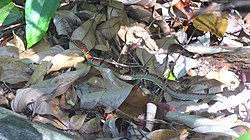
The twin-barred tree snake (Chrysopelea pelias) is a species of colubrid snake found in Southeast Asia. It is also called the banded flying snake. It can glide, as with all species of its genus Chrysopelea, by stretching the body into a flattened strip using its ribs. It is fully arboreal, mostly found in moist forests, and can cover a horizontal distance of about 100 metres in a glide from the top of a tree. It is an oviparous snake. (Full article...) -
Image 2

Micrurus decoratus, more commonly referred to as the Brazilian Coral Snake is a member of Elapidae, a venomous snake family. The coral snake genus Micrurus contains about 50 different species. Micrurus decoratus is restricted to the Atlantic Forest of southeast Brazil. (Full article...) -
Image 3

Bothriechis lateralis is a pit viper species found in the mountains of Costa Rica and western Panama. No subspecies are currently recognized. (Full article...) -
Image 4
Collett's snake (Pseudechis colletti), also commonly known as Collett's black snake, Collett's cobra, or Down's tiger snake, is a species of venomous snake in the family Elapidae. The species is native to Australia. Collett's snake is capable of delivering a fatal bite and is considered the nineteenth most venomous snake in the world. (Full article...) -
Image 5

Cerastes cerastes, commonly known as the Saharan horned viper or the desert horned viper, is a species of viper native to the deserts of Northern Africa and parts of the Arabian Peninsula and Levant. It is often easily recognized by the presence of a pair of supraocular "horns", although hornless individuals do occur. Three subspecies have been described. (Full article...) -
Image 6

Sanzinia madagascariensis, also known as the Madagascar tree boa or Malagasy tree boa, is a boa species endemic to the island of Madagascar. It was once considered conspecific with the Nosy Komba ground boa (Sanzinia volontany). Like all other boas, it is non-venomous. (Full article...) -
Image 7

Boiga forsteni, also known commonly as Forsten's cat snake, is a species of mildly venomous rear-fanged snake in the family Colubridae. The species is endemic to South Asia. (Full article...) -
Image 8
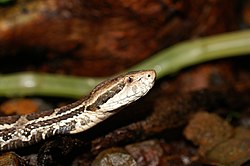
Cerrophidion godmani is a venomous pit viper species native to southern Mexico and Guatemala. No subspecies are recognized as being valid. It is also known commonly as Godman's montane pit viper or Godman's pit viper. (Full article...) -
Image 9
The trinket snake (Coelognathus helena), also known commonly as the common trinket snake, is a species of nonvenomous constricting snake in the family Colubridae. The species is native to southern Central Asia. (Full article...) -
Image 10

The San Francisco garter snake (Thamnophis sirtalis tetrataenia) is a slender multi-colored subspecies of the common garter snake. Designated as an endangered subspecies since the year 1967, it is endemic to San Mateo County and the extreme northern part of coastal Santa Cruz County in California. (Full article...) -
Image 11

The Tokara habu (Protobothrops tokarensis) is a pit viper species endemic to the Tokara Islands of Japan. No subspecies are currently recognized. (Full article...) -
Image 12
-
Image 13
Trimeresurus sumatranus is a species of venomous pitviper (a subfamily of vipers within the larger Viperidae family) found in the tropical forests of Indonesia, Malaysia and Thailand. Arboreal by nature, its coloration is pale to neon-green, with some black vertical markings, and a red-tipped tail. As with other vipers, this species has prominent, "keeled" scales, which appear somewhat raised and give the snake a rough-textured appearance. Common names include Sumatran pitviper, Sumatran tree viper, and Sumatran pit viper. (Full article...) -
Image 14

The Indian cobra (Naja naja /nadʒa nadʒa/), also known commonly as the spectacled cobra, Asian cobra, or binocellate cobra, is a species of cobra, a venomous snake in the family Elapidae. The species is native to the Indian subcontinent, and is a member of the "big four" species that are responsible for the most snakebite cases in Sri Lanka and India. (Full article...) -
Image 15The white-lipped keelback (Hebius leucomystax) is a species of nonvenomous natricine snake found in central Vietnam, Cambodia, and Laos. (Full article...)
-
Image 16
Pantherophis obsoletus, also known commonly as the western rat snake, black rat snake, pilot black snake, or simply black snake, is a nonvenomous species of snake in the family Colubridae. The species is native to central North America west of the Mississippi River. No subspecies are recognized as being valid. Its color variations include the Texas rat snake. Along with other snakes of the eastern United States, like the eastern indigo snake (Drymarchon couperi) and the eastern racer (Coluber constrictor), it is called "black snake". (Full article...) -
Image 17

Bothriechis schlegelii, known commonly as the highland eyelash-pitviper, Schlegel's eyelash-pitviper, eyelash viper or eyelash palm viper, is a species of pit viper in the family Viperidae, native to Colombia. (Full article...) -
Image 18Keelback may refer to any of the following snake genera:
- Amphiesma
- Amphiesmoides, a monotypic genus in the Colubridae with its sole representative, the white-eyed keelback, Amphiesmoides ornaticeps
- Atretium, a monotypic genus in the Colubridae with its sole representative, the split keelback, Atretium schistosum
- Fowlea
- Hebius
- Rhabdophis
- Helicops
- Herpetoreas
- Opisthotropis
- Pseudagkistrodon, a monotypic genus in the Colubridae with its sole representative, the red keelback, Pseudagkistrodon rudis
- Trimerodytes
- Tropidonophis
- Xenochrophis
-
Image 19

The common watersnake (Nerodia sipedon) is a species of large, nonvenomous, common snake in the family Colubridae. The species is native to North America. It is frequently mistaken for the venomous cottonmouth (Agkistrodon piscivorus). (Full article...) -
Image 20

The Cape gopher snake or Baja gopher snake (Pituophis vertebralis) is a species of nonvenomous colubrid snake endemic to extreme southern Baja California Sur, Mexico. They have become increasingly popular companions for people interested in the exotic pet trade, due to their extreme color variations and relatively docile behavior. It was previously considered to be a subspecies of Pituophis catenifer.
There has been controversy whether the Baja Gopher Snake is a lower classification of the Cape Gopher Snake. Some say the Baja Gopher Snake should be in a separate sub-species of Pituophis Vertebralis Bimaris, while Cape Gopher Snakes should remain Pituophis Vertebralis Vertebralis.
Many people mistake the two as the same sub species and have cased some cross-breeding between the two.
In captivity the bloodlines are nearly all related and breeding has become especially difficult in terms of keeping the bloodlines alive. (Full article...) -
Image 21

The forest cobra (Naja melanoleuca), also commonly called the black cobra and the black and white-lipped cobra, is a species of
highly venomous snake in the family Elapidae. The species is native to Africa, mostly the central and western parts of the continent. It is the largest true cobra species with a record length of 3.2 metres (10 feet 6 inches). (Full article...) -
Image 22Night snake may refer to:
- Siphlophis, a snake genus, the spotted night snakes
- Hypsiglena, a snake genus
- Hypsiglena torquata, a species within this genus
- Philodryas agassizii, the burrowing night snake
-
Image 23

Atheris hispida is a viper species endemic to Central Africa. Like all other vipers, it is venomous. It is known for its extremely keeled dorsal scales ("spikes") that give it a bristly appearance. No subspecies are currently recognized. Common names include rough-scaled bush viper, spiny bush viper, hairy bush viper, and others. (Full article...) -
Image 24

Crotalus pyrrhus is a venomous pitviper species found in the southwestern United States and northwestern Mexico. A medium-sized snake, it is found mostly in rocky country, active at night and feeding on small mammals. The coloration is variable and depends on the color of the rocks and soil of the habitat. (Full article...) -
Image 25

Agkistrodon bilineatus (commonly called the cantil, Mexican cantil, Mexican ground pit viper, cantil viper, black moccasin, or Mexican moccasin) is a highly venomous pit viper species found in Mexico and Central America as far south as Honduras. (Full article...)
Selected lizard articles
-
Image 1
The tokay gecko (Gekko gecko) is a nocturnal arboreal gecko in the genus Gekko, the true geckos. It is native to Asia and some Pacific Islands. (Full article...) -
Image 2

Smith's dwarf chameleon (Bradypodion taeniabronchum), also known as the Elandsberg dwarf chameleon, is a species of lizard in the family Chamaeleonidae endemic to Fynbos in South Africa's Eastern Cape. As in several species of chameleons in the genus Bradypodion, the Smith's dwarf chameleon can use its color-changing ability to actively camouflage itself depending on the vision of the specific predator species (for example, bird or snake) by which it is being threatened. (Full article...) -
Image 3West Indian iguana may refer to: (Full article...)
-
Image 4

The Knysna dwarf chameleon (Bradypodion damaranum) is a species of dwarf chameleon in the Bradypodion ("slow footed") genus that is endemic to South Africa. It is a forest dweller, found only in a limited range in the afromontane forests near Knysna, South Africa, and in certain surrounding areas. (Full article...) -
Image 5

Draco norvillii, also known as Norvill's flying lizard, is species of agamid flying lizard endemic to India. This species is capable of gliding from tree to tree, and has been recorded gliding up to 50 metres (160 ft). It feeds on insects and other small invertebrates. (Full article...) -
Image 6

The Alfa Romeo Iguana is a concept car produced by Alfa Romeo in 1969. It was designed by Giorgetto Giugiaro at Italdesign. (Full article...) -
Image 7

The northern Bahamian rock iguana (Cyclura cychlura) is a species of lizard of the genus Cyclura that is found on Andros Island and the Exuma islands in the Bahamas. Its status on the IUCN Red List is vulnerable, with a wild population of less than 5,000 animals. (Full article...) -
Image 8

The Zululand dwarf chameleon (Bradypodion nemorale) is a species of lizard in the family Chamaeleonidae. It is also known as the Qudeni dwarf chameleon.
It is endemic to South Africa. (Full article...) -
Image 9
Draco mindanensis, commonly known as the Mindanao flying dragon or Mindanao flying lizard, is a lizard species endemic to the Philippines. Characterized by a dull grayish brown body color and a vivid tangerine orange dewlap, this species is one of the largest of the genus Draco. It is diurnal, arboreal, and capable of gliding. (Full article...) -
Image 10
Brachylophus bulabula, commonly known as the Central Fijian banded iguana is a species of iguanid lizard endemic to some of the larger central and northwestern islands of Fiji (Ovalau, Kadavu and Viti Levu), where it occurs in Fijian wet forest. It was described by a team led by a scientist from the Australian National University in 2008. It is one of the few species of iguana found outside of the New World and one of the most geographically isolated members of the family Iguanidae. Initially also reported from Gau Island, in 2017 this population was described as a separate species, B. gau. They can grow up to 2 feet long and have an average lifespan of 10-15 years. However, there have been some captive Fiji banded iguanas that have lived as long as 25 years. Fijian banded iguana typically are found in tropical wet islands that are typically 650-1700 feet above sea level. They also like to bask in temperatures ranging from 75–95 °F (24–35 °C). The areas that are most suitable for Fiji banded iguanas are Viti Levu, Vanua Levu, Ovalau, Viwa, and Kadavu. Males are typically are green with blue stripes and the females are green with white stripes. (Full article...) -
Image 11
Draco sumatranus, the common gliding lizard, is a species of agamid lizard endemic to Southeast Asia. It has elongated ribs and skin flaps on the sides of its body. When opened, these skin flaps allow it to glide between tree trunks. (Full article...) -
Image 12
Draco spilonotus, the Sulawesi lined gliding lizard, is a lizard endemic to Sulawesi. The species is known from various localities in forested areas of Sulawesi. (Full article...) -
Image 13
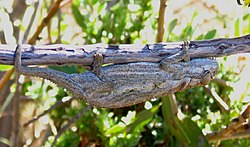
The Swartberg dwarf chameleon (Bradypodion atromontanum) is a species of chameleon endemic to South Africa. (Full article...) -
Image 14
The Nile monitor (Varanus niloticus) is a large member of the monitor family (Varanidae) found throughout most of Sub-Saharan Africa, particularly in drier regions, and along the Nile River and its tributaries in East Africa. Additionally, there are modern, invasive populations in North America. The population found in West African forests and savannahs is sometimes recognized as a separate species, the West African Nile monitor (V. stellatus). While it is dwarfed by its larger relatives, such as the Komodo dragon, the Asian water monitor or the crocodile monitor, it is still one of the largest lizards in the world, reaching (and even surpassing) Australia's perentie in size. Other common names include the African small-grain lizard, as well as iguana and various forms derived from it, such as guana, water leguaan or river leguaan (leguan, leguaan, and likkewaan mean monitor lizard in South African English, and can be used interchangeably). (Full article...) -
Image 15White-throated monitor at Mountain Zebra National Park, South Africa
The rock monitor (Varanus albigularis) is a species of monitor lizard in the family Varanidae. The species is endemic to Sub-Saharan Africa, where, on average, it is the largest lizard found on the continent. It is called leguaan or likkewaan in some areas. (Full article...) -
Image 16

The Ngome dwarf chameleon (Bradypodion ngomeense) is a species of chameleon found in South Africa. (Full article...) -
Image 17
Draco maculatus, commonly known as the spotted flying dragon or spotted gliding lizard, is a species of agamid flying lizard endemic to Southeast Asia. It is capable of gliding from tree to tree. (Full article...) -
Image 18

The Galápagos land iguana (Conolophus subcristatus) is a very large species of lizard in the family Iguanidae, and one of three species of the genus Conolophus. It is endemic to the Galápagos Islands off of Ecuador's Pacific coast, inhabiting the dry lowlands of Fernandina, Isabela, Santa Cruz, North Seymour, Baltra, and South Plaza islands. (Full article...) -
Image 19
The Komodo dragon (Varanus komodoensis), also known as the Komodo monitor, is a large reptile of the monitor lizard family Varanidae that is endemic to the Indonesian islands of Komodo, Rinca, Flores, Gili Dasami, and Gili Motang. The largest extant population lives within the Komodo National Park in Eastern Indonesia. It is the largest extant species of lizard, with the males growing to a maximum length of 3 m (10 ft) and weighing up to 150 kg (330 lb). (Full article...) -
Image 20
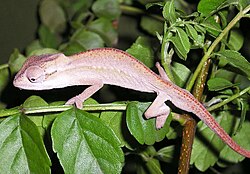
The black-headed dwarf chameleon (Bradypodion melanocephalum) is a lizard of the family Chamaeleonidae endemic to KwaZulu-Natal, South Africa. It is also known as the KwaZulu dwarf chamaeleon and Durban dwarf chameleon. (Full article...) -
Image 21

Chondrodactylus bibronii, commonly known as Bibron's thick-toed gecko, Bibron's sand gecko, or simply Bibron's gecko, is a species of lizard in the family Gekkonidae. The species is native to southern Africa. C. bibronii has been used as an animal model in bioastronautic research examining the effects of spaceflight on the morphology and physiology of vertebrates. (Full article...) -
Image 22

The Indo-Pacific gecko (Hemidactylus garnotii), also known as Garnot's house gecko, fox gecko, or the Assam greyish-brown gecko, is a species of gecko native to South and Southeast Asia, Polynesia, and the east coast of Australia. (Full article...) -
Image 23

Draco cornutus is a species of "flying dragon", an agamid lizard. It is endemic to Borneo. It occurs at elevations up to 700 m (2,300 ft) above sea level, although its distribution is poorly known. (Full article...) -
Image 24
The Cape dwarf chameleon (Bradypodion pumilum) is a chameleon native to the South African province of the Western Cape, where it is restricted to the region around Cape Town. (Full article...) -
Image 25

The clouded monitor (Varanus nebulosus) is a species of monitor lizard, native to Myanmar, Thailand and Laos, Vietnam, to West Malaysia, Singapore, Sumatra, and Java. They are excellent tree climbers. It belongs to the subgenus Empagusia along with the Bengal monitor, the Dumeril's monitor and other monitor lizards. It had previously been listed as a subspecies of Bengal monitor by some herpetologists. It is a diurnal monitor. (Full article...)
Selected turtle articles
-
Image 1
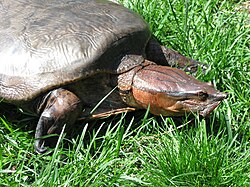
Aubry's flapshell turtle (Cycloderma aubryi) is a species of softshell turtle in the family Trionychidae. The species is endemic to Central Africa. (Full article...) -
Image 2The variable mud turtle (Pelusios rhodesianus), also known as Rhodesian mud turtle, Mashona hinged terrapin or variable hinged terrapin, is a species of turtle in the family Pelomedusidae. It is widely distributed in Central, East, and Southern Africa. The species was officially described by John Hewitt in 1927 and had to be broken into subspecies due to color variations on the heads of the turtles acrost the regions. (Full article...)
-
Image 3
Pan's box turtle (Cuora pani) is a species of turtle in the family Geoemydidae (formerly Bataguridae). The yellow-headed box turtle is sometimes included herein as a subspecies (Cuora pani aurocapitata). (Full article...) -
Image 4A green sea turtle, a species of the sea turtle superfamily
Sea turtles (superfamily Chelonioidea), sometimes called marine turtles, are reptiles of the order Testudines and of the suborder Cryptodira. The seven existing species of sea turtles are the flatback, green, hawksbill, leatherback, loggerhead, Kemp's ridley, and olive ridley. 5 of the seven species are listed as threatened with extinction globally on the IUCN Red List of Threatened Species, the remaining two are not considered to be threatened with extinction. One of which, the flatback turtle, is found only in the waters of Australia, Papua New Guinea, and Indonesia. (Full article...) -
Image 5

Indian peacock softshell turtle (Nilssonia hurum) is a species of turtle found in South Asia and is listed on the IUCN Red List as a vulnerable species. (Full article...) -
Image 6
Kemp's ridley sea turtle (Lepidochelys kempii), also called commonly the Atlantic ridley sea turtle, Kemp's ridley turtle, and Kemp's ridley, is a species of turtle in the family Cheloniidae. L. kempii is the rarest species of sea turtle and is the world's most endangered species of sea turtle as well as the smallest. It is one of two living species in the genus Lepidochelys (the other one being L. olivacea, the olive ridley sea turtle). The species L. kempii primarily occupies habitat around the Gulf of Mexico, though its migrations into the Atlantic Ocean are being affected by rising temperatures. Rising sea temperatures expand this species range, leaving them vulnerable to cold-shocking events when weather changes. Kemp's ridley sea turtle is listed as endangered under the Endangered Species Act (ESA), and conservation efforts are attempting to rebuild population numbers. Human activity, including habitat destruction, climate change, and oil spills, threaten populations. (Full article...) -
Image 7

The Suwannee alligator snapping turtle (Macrochelys suwanniensis) is a large species of turtle in the family Chelydridae. This species is endemic to the southeastern United States, where it only inhabits the Suwannee River basin. (Full article...) -
Image 8

Irwin's turtle (Elseya irwini) is a rare species of freshwater turtle in the family Chelidae. The species is endemic to Australia, originating from the lower region of the Burdekin River area in northern Queensland, and was named after the late conservationist and television personality Steve Irwin. (Full article...) -
Image 9In Indonesia
The Malayan flat-shelled turtle (Notochelys platynota) is a species of turtle found in Southeast Asia.It is the only member of the monotypic genus Notochelys. (Full article...) -
Image 10

The black pond turtle (Geoclemys hamiltonii), also known commonly as the spotted pond turtle and the Indian spotted turtle, is a species of freshwater turtle in the family Geoemydidae. The species, which is endemic to South Asia, belongs to the monotypic genus Geoclemys. (Full article...) -
Image 11
Sternotherus intermedius is a species of small turtle native to Alabama, United States. It is also known as the aliflora musk turtle or intermediate musk turtle due to its intermediate patterns on the shell. For a long time, it was thought to be a hybrid between the two subspecies of the loggerhead musk turtle (the loggerhead and striped-neck musk turtle), but in 2017, it was declared a new species based on DNA research. It is endemic to the Choctawhatchee River and Conecuh River basins. (Full article...) -
Image 12
The Florida box turtle (Terrapene carolina bauri) is a subspecies of turtle belonging to the family Emydidae and is one of six extant subspecies of the common box turtle (T. carolina) (Full article...) -
Image 13
The loggerhead musk turtle (Sternotherus minor) is a species of turtle in the family Kinosternidae. This turtle has a large head which has a light-colored background with dark spots or stripes present on the head and neck. The average size of an adult loggerhead musk turtle is about 3–5 in (7.6–12.7 cm) in straight carapace length. (Full article...) -
Image 14
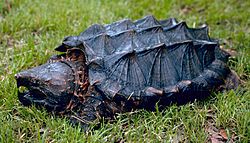
The alligator snapping turtle (Macrochelys temminckii) is a large species of turtle in the family Chelydridae. They are the largest freshwater turtle in North America. The species is endemic to freshwater habitats in the United States. M. temminckii is one of the heaviest living freshwater turtles in the world. It is often associated with, but not closely related to, the common snapping turtle, which is in the genus Chelydra. The specific epithet temminckii is in honor of Dutch zoologist Coenraad Jacob Temminck. (Full article...) -
Image 15The Burmese narrow-headed softshell turtle (Chitra vandijki), also known commonly as the Myanmar narrow-headed softshell turtle and Van Dijk's chitra, is a species of turtle in the family Trionychidae. The species is endemic to Southeast Asia. (Full article...)
-
Image 16Mating, in Oaxaca
The Mexican spotted wood turtle (Rhinoclemmys rubida) or Mexican spotted terrapin is a species of turtle in the family Geoemydidae. (Full article...) -
Image 17Black mud turtle may refer to: (Full article...)
-
Image 18Red turtle may refer to: (Full article...)
-
Image 19

The Jalisco mud turtle (Kinosternon chimalhuaca) is a species of mud turtle in the Kinosternidae family endemic to Mexico. It is found in Colima and Jalisco. They live in freshwater habitats like swamps or quiet rivers. Jalisco mud turtles reproduce oviparous, meaning the eggs hatch after the parent has laid them.
Population size is unknown; there have been less than 20 individuals seen in the last twenty years. The mud turtle is said to be adapted to aquatic habitats, meaning that a population decline is then expected due to habitat fragmentation. (Full article...) -
Image 20
The Tabasco mud turtle (Kinosternon acutum), commonly known as pochitoque in Tabasco, Mexico, is a small turtle which belongs to the family Kinosternidae. It can be found in central Veracruz, Tabasco, northern Guatemala and Belize. This turtle lives in small streams, marshes and ponds. Its feeding habits are mainly carnivorous and it is a nocturnal animal. Although this turtle doesn't have a wide range it can be common at some sites. In Tabasco this turtle is an important part of its popular culture as well as being an ingredient in Tabasco's gastronomy in spite of its special protected status. (Full article...) -
Image 21
The painted turtle (Chrysemys picta) is the most widespread native turtle of North America. It lives in relatively slow-moving fresh waters, from southern Canada to northern Mexico, and from the Atlantic to the Pacific. They have been shown to prefer large wetlands with long periods of inundation and emergent vegetation. This species is one of the few that is specially adapted to tolerate freezing temperatures for extended periods of time due to an antifreeze-like substance in their blood that keeps their cells from freezing. This turtle is a member of the genus Chrysemys, which is part of the pond turtle family Emydidae. Fossils show that the painted turtle existed 15 million years ago. Three regionally based subspecies (the eastern, midland, and western) evolved during the last ice age. The southern painted turtle (C. dorsalis) is alternately considered the only other species in Chrysemys, or another subspecies of C. picta. (Full article...) -
Image 22The African keeled mud turtle (Pelusios carinatus) is a species of turtle in the family Pelomedusidae.
It is endemic to central Africa : the Democratic Republic of the Congo, the Republic of the Congo, and Gabon. (Full article...) -
Image 23The Central African mud turtle (Pelusios chapini) is a species of turtle in the family Pelomedusidae. The species is endemic to Central Africa. (Full article...)
-
Image 24
The chicken turtle (Deirochelys reticularia) is a turtle native to the southeastern United States. It is the only extant member of the genus Deirochelys and is a member of the freshwater marsh turtle family Emydidae. The chicken turtle's scientific name refers to its extremely long neck and distinctive net-like pattern on its upper shell. There are three regionally distinct subspecies (eastern, western and Florida), which are thought to have evolved when populations became separated during periods of glaciation. These subspecies can be distinguished by their appearance; the western chicken turtle displays dark markings along the seams of its plastron (lower shell), while the plastron of the Florida subspecies is a bright yellow or orange color. Fossil records show that the chicken turtle has been present in the region for up to five million years. (Full article...) -
Image 25

The Brazilian radiolated swamp turtle (Acanthochelys radiolata) is a species of turtle in the Chelidae family endemic to Brazil. (Full article...)
Need help?
Do you have a question about Reptiles that you can't find the answer to?
Consider asking it at the Wikipedia reference desk.
Topics
Major extant reptile clades | |||||
|---|---|---|---|---|---|
| Lepidosauria | |||||
| Archelosauria |
| ||||
Related portals
Associated Wikimedia
The following Wikimedia Foundation sister projects provide more on this subject:
-
Commons
Free media repository -
Wikibooks
Free textbooks and manuals -
Wikidata
Free knowledge base -
Wikinews
Free-content news -
Wikiquote
Collection of quotations -
Wikisource
Free-content library -
Wikiversity
Free learning tools -
Wiktionary
Dictionary and thesaurus




![Image 1 Northern tuatara (Sphenodon punctatus punctatus) The tuatara (/tuːəˈtɑːrə/, Māori: [ˈtʉ.a.ta.ɾa]; Sphenodon punctatus) is a species of reptile endemic to New Zealand. Despite its close resemblance to lizards, it is the only extant member of a distinct lineage, the previously highly diverse order Rhynchocephalia. The name tuatara is derived from the Māori language and means "peaks on the back". (Full article...)](https://upload.wikimedia.org/wikipedia/en/d/d2/Blank.png)






